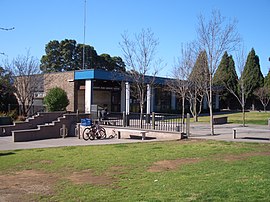Regents Park, New South Wales
|
Regents Park Sydney, New South Wales |
|||||||||||||
|---|---|---|---|---|---|---|---|---|---|---|---|---|---|

Regents Park Amenity Centre
|
|||||||||||||
| Coordinates | 33°53′9″S 151°1′42″E / 33.88583°S 151.02833°ECoordinates: 33°53′9″S 151°1′42″E / 33.88583°S 151.02833°E | ||||||||||||
| Population | 4,511 (2011 census) | ||||||||||||
| Postcode(s) | 2143 | ||||||||||||
| Location | 22 km (14 mi) west of Sydney CBD | ||||||||||||
| LGA(s) | |||||||||||||
| State electorate(s) | |||||||||||||
| Federal Division(s) | Blaxland | ||||||||||||
|
|||||||||||||
Alternate uses:
Regents Park is a suburb in western Sydney, in the state of New South Wales, Australia. Regents Park is located 22 kilometres west of the Sydney central business district, in the local government area of Cumberland Council and Canterbury-Bankstown Council.
Regents Park shares the postcode of 2143 with neighbouring suburbs Birrong and Potts Hill.
The suburb took its name from a local property built by Mr Peck and Mr Johnson in 1879, which they had named after Regent's Park, in the north-west of London, United Kingdom.
The area was originally part of a land grant to Joseph Hyde Potts and the first subdivision was made in 1880. When the school opened in 1899 it was known as Potts Hill School, but became Sefton Park School in 1907 when this area became known as Sefton Park. In 1929 it was changed to Regent Park School. The railway station opened in 1914 as Regents Park but the site was changed in 1924 when the line connected Lidcombe to Bankstown. The suburb is notable in the work of Australian poet Peter Skrzynecki, who grew up in Regents Park. Poems such as 'Feliks Skrzynecki' and 'Regents Park' explore the experiences of postwar migrants in Australia and their life in the growing suburbs of Sydney's west. The poem '10 Mary Street'is about the Skrzynecki family home which still stands today as a tangible example from some of Skrzynecki's best work.
Regents Park railway station is on the Bankstown Line of the Sydney Trains network.
...
Wikipedia

